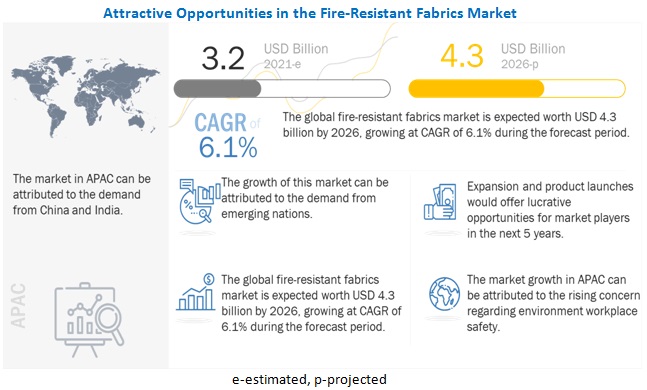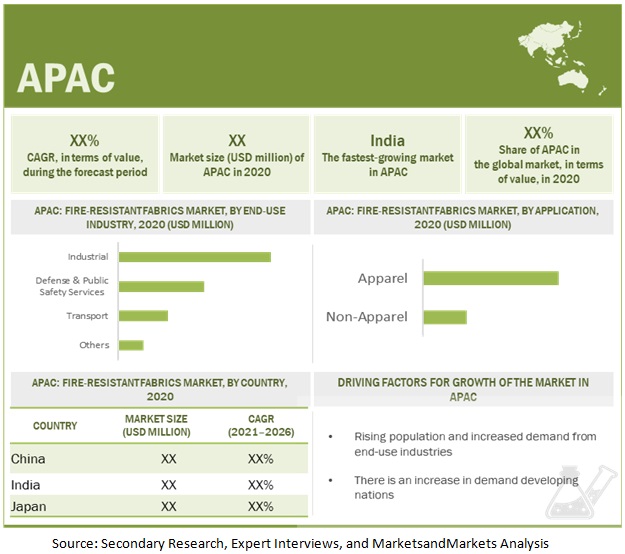According to the new market research report "Fire Resistant Fabrics Market by Type (Treated (FR Cotton and FR Viscose), Inherent (Aramid and PBI)), Application (Apparel, Non-apparel), End Use industry (Industrial, Defense & Public Safety Services, Transportation) - Global Forecasts to 2026", published by MarketsandMarkets™, the Fire Resistant Fabrics Market is projected to reach USD 4.3 billion by 2026, at a CAGR of 6.1% from USD 3.2 billion in 2021.

Browse and in-depth TOC on "Fire Resistant Fabrics Market"
255 - Tables
62 - Figures
291 - Pages
The growth of the fire-resistant fabrics market is primarily triggered by growing concern towards safety at workplace. Industrial protective clothing is the major application for fire-resistant fabrics. Protective clothing is used in key end-use industries such as chemicals, construction, and oil & gas. Among these industries, the major demand has been recorded by the oil & gas sector. Hazardous working conditions necessitate the use of fire-resistant clothing in the industry. The employers have shown increased concern over the safety of their employees due to the regulations in effect and the hidden and direct costs associated with an accident in the workplace. These factors have increased the demand for fire-resistant fabrics to a great extent, which will continue to grow as developing economies start regulating protection equipment in their domestic industrial sector.
Treated is the largest type of fire-resistant fabrics market.
Treated fire-resistant fabrics accounted for the largest share of the overall fire-resistant fabrics market, in terms of value, in 2020. The dominance of treated fabrics is mainly due to their low cost. These fabrics do not possess fire resistance nature in their chemical structure. They are made fire resistant with the help of various chemicals. Chemical additive is treated with the fabric to provide fire resistance to that particular fiber. When exposed to fire, these fabrics rely on chemical reaction to extinguish the fire. There may be a possibility that the fire resistance property of the treated fabric getting washed out through use or laundering.
Apparel is estimated to be the largest application of the fire-resistant fabrics market during the forecast period.
The apparel application accounted for the largest share in terms of value, of the overall fire-resistant fabrics market in 2020. The dominance of the apparel application is projected to continue during the forecast period owing to the high demand from the protective clothing sector. The non-apparel application registered a steady growth, between 2021 and 2026. The market for non-apparel application is mainly driven by the rising demand from transport and furniture sectors.
Sample Pages: https://www.marketsandmarkets.com/requestsampleNew.asp?id=185633312

APAC is estimated to be the largest market for fire-resistant fabrics during the forecast period.
APAC is the largest market for fire-resistant fabrics, followed by North America and Europe. Increasing awareness among consumers regarding the use protective clothing at workplace and implementation of stringent laws by regulatory authorities for labor safety, such as OSHA and other associations, are the key factors driving the growth of the fire-resistant fabrics market in APAC. Fire-resistant fabrics manufacturers are targeting this region as it is the strongest regional market for various applications, such as industrial protective clothing, defense & public safety services, and transport among others. The advantage of shifting production to the Asian region is that the cost of production is low here. Also, it is easier to serve the local emerging market. The lack of safety compliance in the industrial sector and limited use of fire-resistant fabrics in the military sector are the restraints for the market in Asia-Pacific.
The key market players profiled in the report include as E.I. DuPont De Nemours and Company (U.S.), Kaneka Corporation (Japan), PBI Performance Products Inc. (U.S.), Royal TenCate N.V. (Netherlands), Teijin Ltd. (Japan), Westex By Milliken (U.S.), Gun EI Chemical Industry Co., Ltd. (Japan), Huntsman Corporation (U.S.), Lenzing Ag (Austria), Solvay S.A. (Belgium), W. L. Gore Associates Inc. (U.S.), among others.
Get 10% Free Customization on This Report @ https://www.marketsandmarkets.com/requestCustomizationNew.asp?id=185633312
Comments
Post a Comment